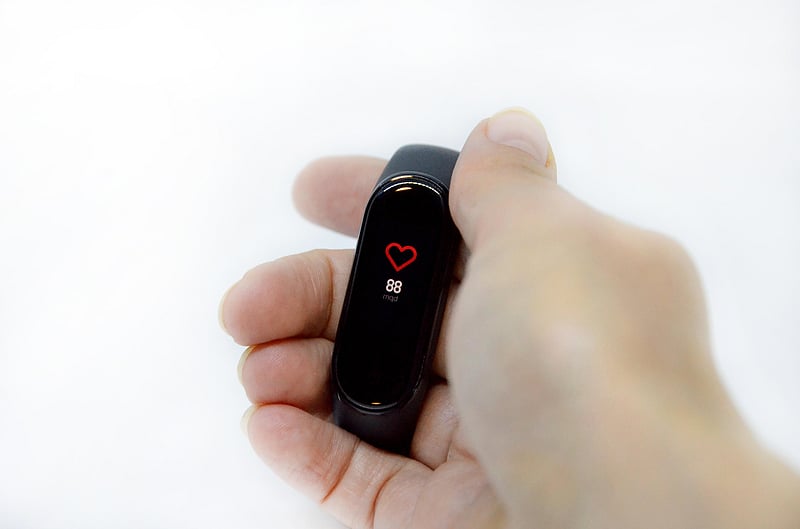 Written by Kara Morris, HealthDay Reporter
Written by Kara Morris, HealthDay Reporter
Wednesday 20 April 2022
Fitness trackers can tell you how well you slept, how fast you walked, and of course how many steps you took.
But during the pandemic, researchers have also investigated the ability of smartwatches to help detect COVID-19 or provide data on recovery.
The latest study uses several measures of heart rate data to help track the progression of symptoms in a person with coronavirus and show how sick that person is during the illness.
In the study, fitness trackers discovered that COVID-19 impairs biological timekeeping signals, said co-author Daniel Forger, a professor of mathematics at the University of Michigan in Ann Arbor. The researchers also found signs of changes in how a person’s heart rate responds to activity, altered resting heart rate and stress signals.
“Most people who use this data think of heart rate as a single number, but heart rate is a vital sign that reflects many different physiological processes,” Forger said. “That’s what our goal as mathematicians is, can we take this series of numbers, all these impulses, with all the noise and everything and say something about the different physiological signals?”
While previous research has involved working to understand the disease through wearable heart rate data, for this effort researchers have focused on breaking the heart rate signal into pieces.
The team used data from the 2019 and 2020 Intern Health Study cohorts, which tracked physicians during their first year of residency, and the Roadmap College Student Dataset, which looked at students’ health and well-being during the 2020-2021 school year. Students in that study wore Fitbits for self-diagnostics and symptoms of COVID-19.
This new study included 43 medical interns and 72 undergraduate and graduate students who had tested positive for COVID-19. They wore their fitness trackers 50 days before and 14 days after onset of symptoms.
The researchers found that when COVID symptoms started, study participants had an increased heart rate for each step. Heart rate per step was significantly higher for individuals with a cough.
The researchers suggested increasing the resting daily heart rate at or before symptoms began, possibly due to fever or increased anxiety.
When symptoms of COVID-19 began, individuals increased “daily phase uncertainty,” which is the body’s inability to determine the timing of daily events. The study authors said this may be consistent with early signs of infection.
Besides affecting the heart rate, the body’s biological clock regulates waking and sleeping patterns, temperature, and more.
“There is already interesting animal work showing that circadian rhythms diminish around the time of injury,” Forger said. “So it makes sense physiologically. In your body, you have these big daily differences, but if you’re sick, your body might not want you to have such big differences. It might just want to stop that time.”
According to the study, the work outlines algorithms that can be used to understand how disease affects heart rate physiology.
Forger said the algorithms are now good enough to really be able to give a bigger picture of health, which could help medical professionals triage patients and make more informed decisions.
“I think now that we have a better understanding of these parameter changes over time, they pave the way for future detection of disease,” said lead author Caleb Meyer, a PhD student in mathematics at the University of Michigan. . “We’re not there yet, but I think splitting the heart rate signal into all of these different systems is really a necessary step toward that goal.”
Matthew Martinez, MD, director of the Atlantic Health System Sports Cardiology Center at Morristown Medical Center in New Jersey and past president of the American College of Cardiology-Council on Sports and Cardio.
Martinez, who was not involved in this study, said he often sees patients who provide him with a large number of data from their trackers.
“I think first of all it’s really important that people continue to take ownership of their health care,” he said.
Martinez added a few caveats to relying on this information. For one thing, the medical community will need to identify data that may be of value.
He said he could see value in being able to monitor someone’s health information and also in collecting data for those who might not be able to easily go to a doctor in person.
“I also love being able to track people in their usual environment, so I can get a better idea of that,” Martinez said. “It also allows for a more affordable, realistic view of what’s happening to patients.”
The study’s limitation was that it did not take into account influenza-like illnesses and did not take into account other factors such as age, weight or gender, or that the data were taken during a time when influenza or other transmitted infections were also high.
The results were published on April 19 in Medicine Cell Reports.
more information
The US Centers for Disease Control and Prevention has more on COVID-19.
SOURCES: Daniel Forger, Ph.D., Professor, Department of Mathematics and Research Professor, Department of Computational Medicine and Bioinformatics, University of Michigan, Ann Arbor, Michigan; Caleb Meyer, PhD Student, Department of Mathematics, University of Michigan, Ann Arbor, Michigan; Matthew Martinez, MD, former president, American College of Cardiology, Council on Sports and Cardiology, and director of the Atlantic Sports Heart System, Morristown Medical Center, Morristown, NJ; Medicine Cell ReportsApril 19, 2022

Copyright © 2020 HealthDay. All rights reserved.





